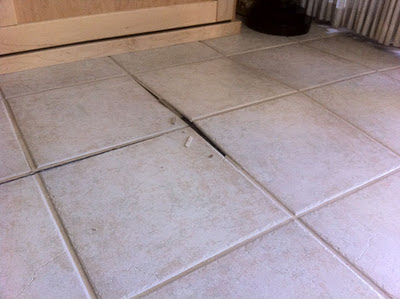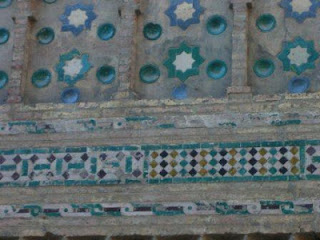New York resident, Constance Zaytoun and Marc Weitz, share some "before and after photos" of their recently completed Chelsea kitchen remodel. The transformation is nothing short of amazing. What makes it even more unbelievable is that Constance didn't hire a designer. She managed all of the construction work herself. All while working and attending school, as I found out later.

A Cement Tile Backsplash adds WOW to this Kitchen Remodel!
Who wouldn't want to savor a cocktail here? Or, make Ratatouille with summer-fresh vegetables. Now look at the "before photo." Yikes! You really need some vision to turn this kitchen around! When you see the transformation you begin to understand that with the right design, anything is possible. Don't be fooled though, these changes take hard work and effort; but, they really are worth it. And what a difference they make! For the record, I refer to Constance in the rest of today's post since I worked with her entirely. But, I know Marc was a major force in the success of this project, too!

Kitchen Before Remodel
When Constance called Avente and spoke to me, I knew she had been talking with other cement tile vendors. She asked detailed questions and was frustrated because of the minimum order quantities that many vendors impose on tile that is "made to order." Avente Tile offers many patterns that don't require a minimum quantity or incur small order surcharges. Constance looked at our
cement tile catalog and found a few patterns that she liked. She followed my advice and ordered the
Eight Piece Heritage Color Chip Set. I explained that this step will help finalize a design, Once you approve the choice of
Heritage colors for the
Ocoa and
Romana patterns, You can then finalize a pattern.
Because we don't stock custom, "tile design lines" like our
Traditional Cement Tile, you should plan on purchasing a strike-off sample to confirm the color, pattern and design. Constance also purchased a sample of the
Mission Trebol A because she liked the pattern and sample stock was available. Once you find a pattern you like, you need to decide on colors. Color chips are necessary. You need to see the texture and how the colors "partner" with other finished surfaces and area light in your home.
Three Cement Tile Patterns Considered Toward the Final Design Stages
Constance liked the
Heritage colors but wasn't certain whether to go with the the
Ocoa Cement Tile or
Romana Cement Tile for the kitchen backsplash.
I recommend getting strike-off samples for any tiles that are custom or when sample stock is not available in standard colorways. You really need to see the tile you are purchasing before a full order arrives at your door step. These are custom, made-to-order tiles just for you. They can't be returned. A few strike-off samples cost about $150 - $400 since they need to be shipped via International Air. It may seem like a lot of money to spend for a small tile job like this; but, it is the cost of a custom design and absolutely necessary. Too many times, I've seen designers and architects disappointed with the colors used on a pattern after seeing a strike-off sample. There might not be enough contract and the pattern "fades" or two much contrast and the pattern creates an unexpected effect.

In a well-designed kitchen all of the surfaces complement each other
In about two weeks, Constance received her strike-off tile samples and you can see Romana was her choice. In the end, this was the best choice because it maintain the clean lines and style in this contemporary kitchen.
The kitchen features some extraordinary materials that all work together to create a warm, inviting kitchen that pops and with energy. The kitchen's cement tile backsplash is definitely the focus. Cement tiles aren't commonly used in kitchen backsplashes or wall installations in the US. However, it is very common in Europe.

Nice choice of color and finishes
A non-traditional mix of texture and color in the other finished surfaces is flawlessly combined to create style and atmosphere. The Zinc countertops are a striking touch and have a hand-made edge finish. They are made in California by
Copperworks. The wall cabinets are made by
Ikea: Rubrick blue accent glass doors with aluminum edge. the color goes great with the cement tile! The base cabinets are maple-faced and sport groovy bakelite knobs and pulls. You'll find
Portola Paints Hollywood on the walls and Globe Thistle on the soffit ceiling.
The kitchen is well-appointed with top-notch tools. There's going to be some good cooking in this kitchen with a
Fagor refrigerator,
Viking range,
Bosch dishwasher,
Kraus faucet,
Houzer sink,
Elica hood, and GE microwave.

The Romana Pattern is used for this Cement Tile Backsplash
The front door is the original metal fire door. It was stripped to bare metal. The open wall shelves are from IKEA and painted with Annie Sloan chalk paints in Paris Grey and Arles.

Solid Color Cement Tiles can be bull-nosed to provide a finished transition
Pendant lights by Original BTC and a Possini ceiling fixture. The flooring is Jelinek Cork Mosaic. And hardwood floors were refinished with Rubio Monocoat fume and silver grey oil plus.Angled power strip and under-cabinet lighting is by Task Lighting.
I hope you enjoyed seeing Marc and Constance's remodeled Chelsea kitchen. What a stunning and well-executed design. Kudos for a job well done! I hope you have a better idea of what to expect when using cement tiles for your project, too. Call us to discuss your project. Take your time and browse our
Cement Tile collection and photos of
cement tile design ideas. You are sure to find a pattern, color and style of cement tile that speaks to you. Now, create the kitchen of your dreams with handmade cement tile.



















